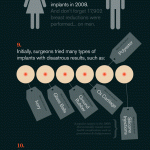Reproductive health is something of a taboo in American society. People in the U.S. don’t really want to have discussions about reproductive health and sexual well-being. However, ignoring the issue of reproductive health isn’t going away. As ultrasound technicians, doctors, nurses, and midwives can tell you, there are a lot of misconceptions out there about reproduction and sexual health. So, while reproductive health may not be something you talk about over the water cooler at work, it is something that you should be educated about. Here are 17 infographics that can help you learn a little more about reproductive health:
Reproduction, Pregnancy and Sexuality Trends
One of the biggest issues out there is teen pregnancy. Another issue is abortion. Additionally, there is a lot of interest in teachings about premarital sex. While these abortion isn’t always related to teen pregnancy and pre-marital sex, it is still an interesting statistic.
- Teen Pregnancy in America: This infographic from Medicine. Technology. Web. features a look at teen pregnancy in America, and correlates it to abstinence-only funding, providing an interesting look at the idea that maybe abstinence-only education is not the best route to take when trying to prevent teen pregnancy. Many of the states that accepted abstinence-only funding saw teen pregnancy rates higher than the national average. Of course, the infographic may not take into account changes since then, as the programs have progressed, and it doesn’t take into account recent arguments that abstinence-only education may be working.
-
 Religious Attitudes and Sex: This relatively simple infographic looks at religious teaches on sex, including teen sex, pre-marital sex, abortion and birth control. It also looks at religious attitudes toward homosexual orientation. You can see a quick comparison of how different religious traditions view different aspects of reproduction and sexual identity and practices. It is interesting to compare the different attitudes, and it can provide you with a look at some of the reproductive traditions held by a large portion of the world. This infographic is found on Flickr, and uses information from ReligiousTolerance.org in its creation.
Religious Attitudes and Sex: This relatively simple infographic looks at religious teaches on sex, including teen sex, pre-marital sex, abortion and birth control. It also looks at religious attitudes toward homosexual orientation. You can see a quick comparison of how different religious traditions view different aspects of reproduction and sexual identity and practices. It is interesting to compare the different attitudes, and it can provide you with a look at some of the reproductive traditions held by a large portion of the world. This infographic is found on Flickr, and uses information from ReligiousTolerance.org in its creation.
-
 Abortion State-by-State: If you are interested in the rate of abortion, you can take a look at this infographic, from CatholicVoteAction.org, to get an idea of which states see more abortions, with relation to the national average. It divides these states into “red” and “blue”, dividing states according to political leanings (liberal or conservative, based on who won the states in in 2008. However, it is important to note that the states used to create the infographic actually come from 2006, before the last presidential election, so it may not exactly match up with attitudes. But it should be fairly close.
Abortion State-by-State: If you are interested in the rate of abortion, you can take a look at this infographic, from CatholicVoteAction.org, to get an idea of which states see more abortions, with relation to the national average. It divides these states into “red” and “blue”, dividing states according to political leanings (liberal or conservative, based on who won the states in in 2008. However, it is important to note that the states used to create the infographic actually come from 2006, before the last presidential election, so it may not exactly match up with attitudes. But it should be fairly close.
-
 Homosexuality: How has homosexuality evolved? You can find out more about gay behavior, and where it might have come from, with help from this io9 infographic, based on information about evolutionary sexuality from New Scientist. Learn about how different sexual traits might have developed, and the purpose for some of them. You can also compare the development of homosexuality in other species to homosexuality in humans. Apparently, in some cases, a tendency toward gayness develops for very specific reasons. In other cases, reasons are a little less pronounced. A very interesting infographic for those who are interested in how our sexual preferences might have evolved.
Homosexuality: How has homosexuality evolved? You can find out more about gay behavior, and where it might have come from, with help from this io9 infographic, based on information about evolutionary sexuality from New Scientist. Learn about how different sexual traits might have developed, and the purpose for some of them. You can also compare the development of homosexuality in other species to homosexuality in humans. Apparently, in some cases, a tendency toward gayness develops for very specific reasons. In other cases, reasons are a little less pronounced. A very interesting infographic for those who are interested in how our sexual preferences might have evolved.
-
 Timeline of Abstinence-Only Education: Want to know how much has been spent on abstinence-only education in the U.S.? Here is an interesting infographic from Blogging Censorship that offers information on how federal funds have been used with regard to sex ed and abstinence-only education since 1981. Depending on where you stand, this is either good news or bad news.
Timeline of Abstinence-Only Education: Want to know how much has been spent on abstinence-only education in the U.S.? Here is an interesting infographic from Blogging Censorship that offers information on how federal funds have been used with regard to sex ed and abstinence-only education since 1981. Depending on where you stand, this is either good news or bad news.

Sexually Transmitted Diseases (STDs) and Pornography
Learn a little bit more about STDs, and what you can expect from them, as well as facts about their spread. Also included are infographics on pornography.
-
 STDs in America: Learn some basic stats about STDs in America. This includes information about STDs, as well as information on HIV/AIDS. Some of the information addresses STDs in high school, as well as STDs in the general population. This even includes “fun facts” about sexually transmitted diseases amongst porn stars and ways that you can contract sexually transmitted diseases. It’s a sometimes surprising look at STDs and their prevalence, and where you are likely to encounter them. Plus, this infographic will give you something to think about before you have unprotected sex.
STDs in America: Learn some basic stats about STDs in America. This includes information about STDs, as well as information on HIV/AIDS. Some of the information addresses STDs in high school, as well as STDs in the general population. This even includes “fun facts” about sexually transmitted diseases amongst porn stars and ways that you can contract sexually transmitted diseases. It’s a sometimes surprising look at STDs and their prevalence, and where you are likely to encounter them. Plus, this infographic will give you something to think about before you have unprotected sex.
-
 HIV: Want to know which countries are making progress in combating AIDS? This World AIDS Day infographic on GOOD offers a look at how different countries are doing, showing which have reduced their HIV positive populations the most — and which are seeing a big increase. Estimates put the total number of people with HIV at 33 million right now, assuming reporting is accurate. You can learn more about HIV/AIDS and get a better idea of where we are at — and how much further we have to go in order to get the HIV/AIDS epidemic under control as a concerned global community.
HIV: Want to know which countries are making progress in combating AIDS? This World AIDS Day infographic on GOOD offers a look at how different countries are doing, showing which have reduced their HIV positive populations the most — and which are seeing a big increase. Estimates put the total number of people with HIV at 33 million right now, assuming reporting is accurate. You can learn more about HIV/AIDS and get a better idea of where we are at — and how much further we have to go in order to get the HIV/AIDS epidemic under control as a concerned global community.
-
 Porn and the Economy: Learn about how things are going in the pornography industry, and what the industry expects going forward. Even though porn is huge, this infographic published on PotPotato looks the implications of an industry that is being upstaged by free content on the Web and other issues (like high paid porn stars). Can porn survive all the free content that is now available? And what is porn’s impact on the overall economy, anyway? You can learn by looking at this infographic, as well as see where the U.S. ranks in pornography use as compared to other countries in the world.
Porn and the Economy: Learn about how things are going in the pornography industry, and what the industry expects going forward. Even though porn is huge, this infographic published on PotPotato looks the implications of an industry that is being upstaged by free content on the Web and other issues (like high paid porn stars). Can porn survive all the free content that is now available? And what is porn’s impact on the overall economy, anyway? You can learn by looking at this infographic, as well as see where the U.S. ranks in pornography use as compared to other countries in the world.
-
 Porn by Numbers: This surprising infographic from Gunaxin Media offers a look at pornography trends in the U.S. From learning that “porn” and “sex” account for two of the top five searches for kids under the age of 18, to getting an idea of how much different countries spend on porn, to learning that Utah has the highest per capita consumption of porn, you can find out a number of interesting facts about how we use pornography as a society, in the United States of America and around the world.
Porn by Numbers: This surprising infographic from Gunaxin Media offers a look at pornography trends in the U.S. From learning that “porn” and “sex” account for two of the top five searches for kids under the age of 18, to getting an idea of how much different countries spend on porn, to learning that Utah has the highest per capita consumption of porn, you can find out a number of interesting facts about how we use pornography as a society, in the United States of America and around the world.
Genetics and Reproductive Development
Find out more about genes, reproduction and cloning from the following infographics.
- Cloning: Concerned about cloning? Many people are, with the word conjuring images of soul-less masses. This handy infographic can help you learn to distinguish between research cloning and reproductive cloning. So, while cloning is used in research, and for some procedures, actually using reproductive cloning on a widespread basis with humans is still a very long way into the future. However, research and therapeutic cloning could hold some keys to the curing of diseases.
-
 Breasts: This fascinating developmental infographic illustrates 15 things you should know about breasts. This great infographic offers insight into interesting facts, such as the average breast weighs 1.1 pounds, and that the average breast size has increased over the last 15 years. You can also learn other facts — such as that nearly 18,000 breast reductions were performed on men in 2008. So breasts aren’t only about women. It kind of makes you want to take a second look at these important parts of the reproductive cycle, and learn a little bit more about how they do what they do.
Breasts: This fascinating developmental infographic illustrates 15 things you should know about breasts. This great infographic offers insight into interesting facts, such as the average breast weighs 1.1 pounds, and that the average breast size has increased over the last 15 years. You can also learn other facts — such as that nearly 18,000 breast reductions were performed on men in 2008. So breasts aren’t only about women. It kind of makes you want to take a second look at these important parts of the reproductive cycle, and learn a little bit more about how they do what they do.
-
 Menstrual Cycle: Human reproduction has a tough time of it without the menstrual cycle. If you are interested in learning how the menstrual cycle works, and what happens inside the body during this time, you can learn from this colorful and interesting cartoonish infographic on imgur. An interesting journey through the female reproductive system, this infographic highlights the changes in the body during the menstrual cycle, as well as what makes the whole thing work, as well as some helpful hints about how and why some women feel and act certain ways during the month.
Menstrual Cycle: Human reproduction has a tough time of it without the menstrual cycle. If you are interested in learning how the menstrual cycle works, and what happens inside the body during this time, you can learn from this colorful and interesting cartoonish infographic on imgur. An interesting journey through the female reproductive system, this infographic highlights the changes in the body during the menstrual cycle, as well as what makes the whole thing work, as well as some helpful hints about how and why some women feel and act certain ways during the month.
-
 Semen: Learn about male reproductive health with this infographic from Spurs Fan Says. Learn interesting facts about semen — how it is produced, how fast it moves, and how much volume it takes up. Also included: How long sperm can live inside a woman or on a toilet seat. You can also compare human sperm ejaculation to that of other animals. Learn how different foods you eat can affect semen, and some interesting beliefs about becoming a man in different cultures.
Semen: Learn about male reproductive health with this infographic from Spurs Fan Says. Learn interesting facts about semen — how it is produced, how fast it moves, and how much volume it takes up. Also included: How long sperm can live inside a woman or on a toilet seat. You can also compare human sperm ejaculation to that of other animals. Learn how different foods you eat can affect semen, and some interesting beliefs about becoming a man in different cultures.
Population Growth
Get information on population and reproductive trends for different cultural, religious and racial groups.
- Muslim Populations Worldwide: This interesting infographic from PBS.org addresses the population trends related to Islam. It looks at population growth amongst Muslims in different areas around the world, including in Europe and North America. It also projects the possible growth out to 2025. One of the most interesting figures is the growth of the Muslim population in France, which is seeing a large increase as the immigrant population has more babies, white French citizens reproduce at a slower rate.
-
 U.S. Population Growth through 2050: The U.S. Census Bureau offers an interesting infographic showing population growth projections through 2050 by race. While whites will still be the majority in the U.S. by then, it is clear that the trend is toward an increase in current minority populations, probably due to the higher rates of reproduction in other populations, since whites are having babies at slower rates. Charlie Gibson generated controversy a couple of years ago by calling whites to action to make more babies in an effort to keep other races from catching up to, and eventually overcoming, the white population.
U.S. Population Growth through 2050: The U.S. Census Bureau offers an interesting infographic showing population growth projections through 2050 by race. While whites will still be the majority in the U.S. by then, it is clear that the trend is toward an increase in current minority populations, probably due to the higher rates of reproduction in other populations, since whites are having babies at slower rates. Charlie Gibson generated controversy a couple of years ago by calling whites to action to make more babies in an effort to keep other races from catching up to, and eventually overcoming, the white population.
-
 Population and Inhabitable Land: One of the issues that comes up when we talk about reproductive health and population is the idea that Earth is overpopulated. However, this might not be entirely the case — at least in some places. Human.org.au offers an interesting infographic that illustrates how “full” different countries are with regard to the livable land available. Perhaps we’re not quite on the verge of running out of roon. Turns out (if you believe the infographic) that there is still plenty of room to grow in the U.S. and Britain, but, according to this infographic South Korea is definitely full.
Population and Inhabitable Land: One of the issues that comes up when we talk about reproductive health and population is the idea that Earth is overpopulated. However, this might not be entirely the case — at least in some places. Human.org.au offers an interesting infographic that illustrates how “full” different countries are with regard to the livable land available. Perhaps we’re not quite on the verge of running out of roon. Turns out (if you believe the infographic) that there is still plenty of room to grow in the U.S. and Britain, but, according to this infographic South Korea is definitely full.
- Infant Mortality: This interesting infographic from Gapminder shows that infant mortality rises in poorer countries. It shows the population of different countries as well. Interestingly, the U.S. has one of the highest infant mortality rates of developed countries. Some point to premature births as one of the main reasons the U.S. has such a high infant mortality rate for its wealth. Some even claim that the high number of premature births indicates that the U.S. is not where it should be in terms of reproductive health and prenatal care.
 Our blog focuses on the professional and educational development of ultrasound technicians. Gloria Lokos is an experienced Registered Diagnostic Cardiac Sonographer proficient in both cardiac and vascular ultrasound. She has over ten years of diverse clinical experience in the healthcare industry. Follow along, as she posts about the latest news, information and research!
Our blog focuses on the professional and educational development of ultrasound technicians. Gloria Lokos is an experienced Registered Diagnostic Cardiac Sonographer proficient in both cardiac and vascular ultrasound. She has over ten years of diverse clinical experience in the healthcare industry. Follow along, as she posts about the latest news, information and research!